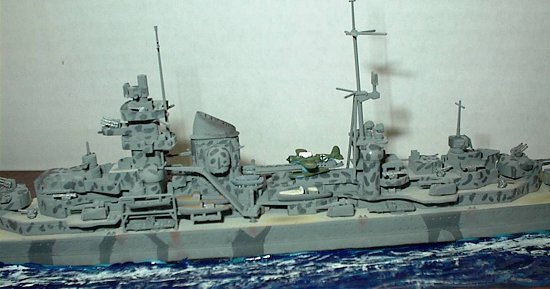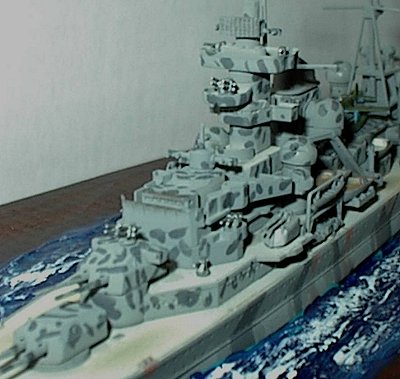
Tamiya 1/700 Prinz Eugen
|
KIT # |
31805 |
|
PRICE: |
$31.00 |
|
DECALS: |
|
|
REVIEWER: |
Len Roberto |
|
NOTES: |
|

|
HISTORY |
I’ll just repeat a short history that I wrote for the preview of this kit:
The German Heavy Cruiser Prinz Eugen accompanied the Bismarck on the ill-fated Operation Rhine in May 1941. The cruiser was dispatched after the battle with the Hood and Prince of Wales and was not at hand to suffer the same fate as the Bismarck. In fact, the Prinz Eugen survived the war entirely. She remained in Brest until the famed “Channel Dash” - Operation Cerebus in February 1942.
After the end of WWII,
the Prinz Eugen was allocated to the U.S. Navy and was classified IX-300. In
January 1946 she steamed, with an American and German crew, to Boston. She was
then sent on to Philadelphia where she had the two 8" (20.3 cm) cannons from her
"A" turret removed. These guns were then shipped to the Navy's Weapon facility
at Dahlgren, Virginia, for testing. They are now on display there.
Proceeding via the Panama Canal to the Pacific for atomic bomb tests, she
survived an atomic explosion at Bikini 25 July 1946, and was towed to Kwajalein
where she began to list significantly on 21 December. Despite an attempt to
beach her, she capsized and sank 22 December 1946 on a coral reef at Enubuj,
Kwajalein Atoll.
|
THE KIT |
 As I stated in my preview of
this kit, Tamiya’s new 1/700 scale waterline Prinz Eugen takes the detail of
last year’s Indianapolis kit and goes one better. In short, this kit is a
beauty. You get four sprues: one with the hull, deck and flat waterline
bottom, one with the superstructure assembly, and two armaments and ancillary
equipment sprues. The kit also provides instructions and parts to build the
cruiser as she appeared with the Bismarck or during the Channel Dash-- Operation
Cerberus in February 1942 with a different camo scheme.
As I stated in my preview of
this kit, Tamiya’s new 1/700 scale waterline Prinz Eugen takes the detail of
last year’s Indianapolis kit and goes one better. In short, this kit is a
beauty. You get four sprues: one with the hull, deck and flat waterline
bottom, one with the superstructure assembly, and two armaments and ancillary
equipment sprues. The kit also provides instructions and parts to build the
cruiser as she appeared with the Bismarck or during the Channel Dash-- Operation
Cerberus in February 1942 with a different camo scheme.
Molding is crisp and the level of detail attained in this scale is amazing. As with the Indianapolis kit, the tiny antiaircraft armament, searchlights, torpedo tubes, and ship’s boats possess a level of intricacy that you have to see to believe. It is so good that I decided to not use any photo etching except for the three box-like radars, which I had replacements for, and a nice aircraft catapult to replace the chunky kit part.
|
CONSTRUCTION |
I started by gluing the two hull halves to the flat waterline bottom. The kit-supplied weight was superglued to the hull bottom for heft and then the one-piece deck was glued onto the hull. Fit here was superb. A few elastic bands made sure the deck fit snugly and no putty was needed at all.
I then proceeded to assemble the rest of the kit in sub-assemblies, which included: 4 main armament turrets, high angle anti-aircraft weapons, bridge, stack, and the aft superstructure with mast.
Everything fit together crisply with no trouble. Some of the parts are quite tiny and a good tweezers is mandatory. Once these sub-assemblies were completed, I proceeded to paint and mask.
|
PAINTING |
I chose to model the ship as it appeared in February 1942 during the famed Channel Dash. I chose this scheme because it looked quite attractive and the black and white stripe pattern is seen everywhere! After reading some online discussions about the ship’s paintwork, it appears there is some controversy and no definitive proof on Prinz Eugen’s camo from any period. There is a lack of photographic evidence and what you read is sometimes confusing.
 Anyway, the first
task was to spray the deck with Tamiya Deck Tan XF-55. I would enhance this
later on with chalk pastels. When dry, I spent a good hour masking the entire
deck with tiny pieces of Scotch tape and a sharp #11 blade. The wood decks were
also present on upper levels so it was a tedious experience to get these little
pieces of tape to stay down and fit around a curve! Without a doubt, this is
the part that I hate the most but I am learning that doing this part right makes
a huge difference in the cleanliness and neatness of your model.
Anyway, the first
task was to spray the deck with Tamiya Deck Tan XF-55. I would enhance this
later on with chalk pastels. When dry, I spent a good hour masking the entire
deck with tiny pieces of Scotch tape and a sharp #11 blade. The wood decks were
also present on upper levels so it was a tedious experience to get these little
pieces of tape to stay down and fit around a curve! Without a doubt, this is
the part that I hate the most but I am learning that doing this part right makes
a huge difference in the cleanliness and neatness of your model.
When satisfied that all was ready, the next color was sprayed. This color was Tamiya Dark Sea Grey XF-54. This was sprayed on the entire hull and all superstructure assemblies. After letting this dry for a while, I again spent an hour masking the hull. The pattern calls for Dark Grey XF-24 in a pattern that slashes down the hull towards the water and the bow and stern portions were also Dark Grey. I used Scotch tape and cut out the patterns with a blade. I airbrushed the Dark Grey on the hull and a few minutes later pulled off the masks.
I decided to glue the sub-assemblies onto the deck before painting the blotches of grey to aid me with placement. The directions called for Field Grey XF-65 but I used a mixture of Neutral Grey and Light Grey. I thinned it down and picked my finest brush to delicately apply the blotches. It mostly consists of tiny slashes on all vertical surfaces and on the tops of the turrets, bridge and direction finders. I laid the instruction pattern behind the model and worked on one portion at a time like turret one and then moved onto to another section. I should have made the blotches even thinner—it’s easy to lose your focus when going back and forth from model to instructions, etc. Anyway, I am happy with the result.
|
CONSTRUCTION CONTINUES |
Once the camo was completed, it was ready for launch. Instead of using modeling paste, I decided to use only the thick Liquitex paint for simulated water. I mixed a batch of blue and green that was then plopped onto my base. I spread the paint around and used a piece of folded paper to craft a light sea.
 After this had
dried, it was on to a light weathering session. I use chalk pastel dust smudged
on with a stiff old brush. I use a reddish brown concoction lightly dusted onto
anchors, boat davits, and on random areas around the hull. I use black to
accent around the funnel top. Finally, the deck tan color is enhanced by using
a light brushing of beige, yellow and tan chalk dust.
After this had
dried, it was on to a light weathering session. I use chalk pastel dust smudged
on with a stiff old brush. I use a reddish brown concoction lightly dusted onto
anchors, boat davits, and on random areas around the hull. I use black to
accent around the funnel top. Finally, the deck tan color is enhanced by using
a light brushing of beige, yellow and tan chalk dust.
I attached a Kriegsmarine flag on the stern with CA glue. I could not for the life of me on the directions find where to attach the decal of the ship’s crest – I will have to hunt for a picture or notation of where this should be placed. The floatplane was glued together and painted deep green topside and a light blue underside. German cross decals were applied. I shot a flat coat onto the ship, brushed two coats of Future onto the water base and there you have it.
|
CONCLUSIONS |
This kit was an absolute joy to build. Everything fits and the level of detail kept me interested throughout. When a kit is this well done, it forces me to give it my utmost in terms of patience and care. This kit would make a terrific first project for anyone wanting to give small scale ship modeling a try or if you just want to take a diversion from your normal fare. I can’t praise this kit enough!
|
REFERENCES |
http://www.kbismarck.com/peugen.html
http://www.warship.org/no31990.htm
http://www.warships1.com/GERca05_AHipper.htm
Copyright ModelingMadness.com
If you would like your product reviewed fairly and fairly quickly, please contact the editor or see other details in the Note to Contributors.
Back to Reviews Page 2018